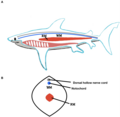Shark anatomy
Shark Anatomy refers to the physical structure and biological systems of sharks, a group of elasmobranch fish characterized by a cartilaginous skeleton, five to seven gill slits on the sides of the head, and pectoral fins that are not fused to the head.
External Anatomy
The external anatomy of sharks is defined by several unique characteristics.
Skin
The skin of a shark is made up of a complex dermal corset made of flexible collagenous fibers and arranged as a helical network surrounding the body. The skin is covered in placoid scales, also known as dermal denticles, which provide a hydrodynamic advantage as the shark moves through water.
Fins
Sharks have several types of fins, including dorsal fins, pectoral fins, pelvic fins, and a caudal fin. The dorsal fin provides stability while swimming. Pectoral fins assist with steering and lift. Pelvic fins aid in stabilization, and the caudal fin propels the shark forward.
Teeth
Shark teeth are embedded in the gums rather than directly affixed to the jaw, and are constantly replaced throughout the shark's life. The shape and size of shark teeth vary according to the shark's diet.
Internal Anatomy
The internal anatomy of sharks includes the skeletal system, digestive system, respiratory system, circulatory system, and sensory systems.
Skeletal System
Unlike most fish, sharks have a completely cartilaginous skeleton. This reduces the shark's weight and provides additional flexibility.
Digestive System
The digestive system of a shark includes the mouth, teeth, jaws, esophagus, stomach, intestines, and cloaca. Sharks have a U-shaped stomach that is capable of distending to accommodate large meals.
Respiratory System
Sharks breathe through a series of five to seven gill slits located on either side of their bodies. Water flows over the gills as the shark swims, allowing oxygen to enter the bloodstream and carbon dioxide to be expelled in a process known as respiration.
Circulatory System
Sharks have a two-chambered heart and a circulatory system that functions on the principle of single circulation, with the blood passing through the heart only once during each trip around the body.
Sensory Systems
Sharks have highly developed sensory systems, including sight, smell, taste, hearing, touch, and electroreception. The latter allows them to detect the electric fields produced by other animals, aiding in hunting and navigation.
See Also
References
This ichthyology related article is a stub. You can help WikiMD by expanding it.
Shark anatomy gallery
Transform your life with W8MD's budget GLP-1 injections from $125.
W8MD offers a medical weight loss program to lose weight in Philadelphia. Our physician-supervised medical weight loss provides:
- Most insurances accepted or discounted self-pay rates. We will obtain insurance prior authorizations if needed.
- Generic GLP1 weight loss injections from $125 for the starting dose.
- Also offer prescription weight loss medications including Phentermine, Qsymia, Diethylpropion, Contrave etc.
NYC weight loss doctor appointments
Start your NYC weight loss journey today at our NYC medical weight loss and Philadelphia medical weight loss clinics.
- Call 718-946-5500 to lose weight in NYC or for medical weight loss in Philadelphia 215-676-2334.
- Tags:NYC medical weight loss, Philadelphia lose weight Zepbound NYC, Budget GLP1 weight loss injections, Wegovy Philadelphia, Wegovy NYC, Philadelphia medical weight loss, Brookly weight loss and Wegovy NYC
|
WikiMD's Wellness Encyclopedia |
| Let Food Be Thy Medicine Medicine Thy Food - Hippocrates |
Medical Disclaimer: WikiMD is not a substitute for professional medical advice. The information on WikiMD is provided as an information resource only, may be incorrect, outdated or misleading, and is not to be used or relied on for any diagnostic or treatment purposes. Please consult your health care provider before making any healthcare decisions or for guidance about a specific medical condition. WikiMD expressly disclaims responsibility, and shall have no liability, for any damages, loss, injury, or liability whatsoever suffered as a result of your reliance on the information contained in this site. By visiting this site you agree to the foregoing terms and conditions, which may from time to time be changed or supplemented by WikiMD. If you do not agree to the foregoing terms and conditions, you should not enter or use this site. See full disclaimer.
Credits:Most images are courtesy of Wikimedia commons, and templates, categories Wikipedia, licensed under CC BY SA or similar.
Contributors: Prab R. Tumpati, MD








